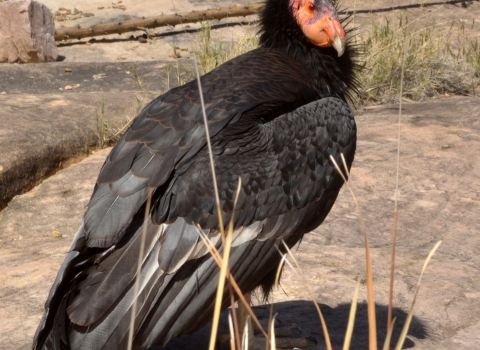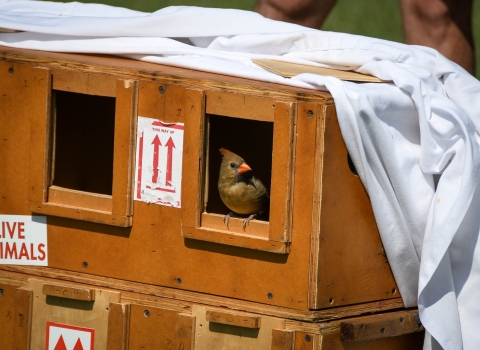Lee la historia en español aquí
The U.S. Fish and Wildlife Service is proposing protection for one of the nation’s most beloved species -- the monarch butterfly -- and is encouraging the public to be part of its recovery. The Service is seeking public input on a proposal to list the species as threatened with species-specific protections and flexibilities to encourage conservation under section 4(d) of the Endangered Species Act (ESA). Public comments will be accepted on the proposal until March 12, 2025. The Service will then evaluate the comments and any additional information on the species and determine whether to list the monarch butterfly.
“The iconic monarch butterfly is cherished across North America, captivating children and adults throughout its fascinating lifecycle. Despite its fragility, it is remarkably resilient, like many things in nature when we just give them a chance,” said U.S. Fish and Wildlife Service Director Martha Williams. “Science shows that the monarch needs that chance, and this proposed listing invites and builds on unprecedented public participation in shaping monarch conservation efforts. Providing monarchs with enough milkweed and nectar plants, even in small areas, can help put them on the road to recovery. Working together, we can help make this extraordinary species a legacy for our children and generations to come.”
For more than 50 years, the ESA has been an effective catalyst for on-the-ground collaborative conservation, promoting the recovery of wildlife and conserving the habitats upon which they depend. This proposed rule will help build on and enhance monarch conservation efforts while balancing activities in support of economic growth.
With its notable orange and black markings, the monarch butterfly is one of the most recognizable insects in the world. In North America, monarchs are grouped into two long-distance migratory populations. The eastern migratory population is the largest and overwinters in the mountains of central Mexico. The western migratory population primarily overwinters in coastal California. In the 1980s, over 4.5 million western monarchs flocked to overwintering grounds in coastal California. In the mid-1990s, an estimated 380 million eastern monarchs made the long-distance journey to overwintering grounds in Mexico, completing one of the longest insect migrations in the world.
Today, the eastern migratory population is estimated to have declined by approximately 80%. The western migratory population has declined by more than 95% since the 1980s, putting the western populations at greater than 99% chance of extinction by 2080. During this same period, the probability of extinction for eastern monarchs ranges from 56 to 74%, according to the Service’s most recent species status assessment.
Threats to monarchs include loss and degradation of breeding, migratory and overwintering habitat; exposure to insecticides; and the effects of climate change climate change
Climate change includes both global warming driven by human-induced emissions of greenhouse gases and the resulting large-scale shifts in weather patterns. Though there have been previous periods of climatic change, since the mid-20th century humans have had an unprecedented impact on Earth's climate system and caused change on a global scale.
Learn more about climate change . Although many people have already helped conserve the butterfly, additional habitat and protections are needed to ensure the species is conserved for future generations.
To assist with monarch conservation efforts, the Service is also proposing critical habitat for the species at a portion of its overwintering sites in coastal California. Overwintering habitat provides an essential resting place for monarchs during the cold winter months and helps them prepare for breeding in the early spring. In total, the Service is proposing 4,395 acres of critical habitat for the western migratory monarch population across Alameda, Marin, Monterey, San Luis Obispo, Santa Barbara, Santa Cruz and Ventura counties in California. A critical habitat designation imposes no requirements on state or private land unless the action involves federal funding, permits or approvals.
The Service collaborates closely with Tribes, federal and state agencies, academic institutions and non-government organizations to carry out conservation efforts for the monarch butterfly. Many partners across the monarch’s range are involved in surveys, monitoring and habitat improvements. Much of this work takes place on private lands with the support of local landowners.
The proposal to list the monarch butterfly, and designate critical habitat, will publish in the Federal Register on December 12, 2024. A 90-day comment period will open on December 12, 2024, and will close on March 12, 2025. Information about how to submit comments can be found on regulations.gov by searching for docket number FWS-R3-ES-2024-0137. This docket also includes information about how to attend two virtual public information meetings, and associated public hearings, about this listing proposal.
Everyone can play a role in saving the monarch butterfly. Because of the species’ general habitat use and wide distribution, all sectors of society have an opportunity to participate in a broad range of conservation efforts throughout the butterfly’s range. For more information about the monarch listing proposal, and how to help conserve monarch butterflies, please visit: https://www.fws.gov/monarch.
WHAT THEY ARE SAYING
“State agencies and their partners have taken monumental steps to create and restore thriving ecosystems and habitats for the monarch butterfly,” said Judy Camuso, Commissioner of the Maine Department of Inland Fisheries and Wildlife and President of the Association of Fish and Wildlife Agencies. “Cooperation across government entities and private partners is central to all conservation efforts but is even more critical with keystone species. We thank the Service for recognizing the need for these partnerships and are committed to working with them to account for the many complexities at stake in ensuring healthy and robust pollinator populations.”
“Beginning in 1982, the mission of Pheasants Forever and Quail Forever has been to restore grassland ecosystems for the benefit of pheasants, quail, and other wildlife. When you consider the web of life, it’s no coincidence our millions of wildlife habitat projects have delivered tremendous benefits for pollinating insects and monarch butterflies at the same time we’ve delivered habitat improvements for game birds,” said Marilyn Vetter, President and CEO of Pheasants Forever and Quail Forever. “Moving forward, our commitment is continued focus on the intersection between private and public lands, with myriad private and public partners, for the conservation of America’s grasslands. Likewise, our organization will continue to advocate for voluntary, incentive-based grasslands-focused programs for landowners, farmers, ranchers, and hunters as the number one strategy for recovering monarch populations.”
“The members of the National Alliance of Forest Owners use sustainable forest management to provide forest products and jobs in a way that cleans our air and water and provides abundant wildlife habitat for the long term," said Dave Tenny, President and CEO of the National Alliance of Forest Owners. “Sustaining wildlife is as foundational to the modern culture of private forest owners as sustaining rural communities. We need both, and we view them as mutually dependent. This stewardship ethic is especially beneficial to monarch butterflies and other pollinators, because we intentionally provide the habitat they need as an essential part of our businesses. By managing our forests in this way, we do our part to help monarchs thrive while helping people take pride in knowing they are part of a conservation solution."
“The monarch butterfly and its remarkable multi-generation migration are marvels of the natural world. This science-based decision is a national call to action for all Americans to save this majestic species by joining forces to plant native milkweed and nectar plants all across the nation – our yards, schools, parks, rights-of-way, businesses, places of worship, working lands, and so much more. By working collaboratively, we will recover and safeguard this iconic species for future generations.” - Collin O’Mara, president and CEO, National Wildlife Federation
"Monarch butterflies are not only a symbol of resilience but also a force that brings people together to protect our natural world. As their populations continue to decline, proactive conservation is essential to secure their future. We look forward to continuing our collaboration with the U.S. Fish and Wildlife Service and other partners to ensure monarchs thrive for generations, inspiring communities and sustaining the ecosystems we all depend on."
- Wendy Caldwell, Executive Director, Monarch Joint Venture
"Economic prosperity and ecological health go hand in hand,” said Lesli Allison, Chief Executive Officer of the Western Landowners Alliance. “Working lands, which provide the food, fiber and energy on which people depend also provide essential habitat for the majority of wildlife species, including monarch butterflies. Pollinators are an integral part of our ecosystem and it is incumbent upon all of us to do what we can to ensure these species can survive and thrive. We look forward to learning the details of the proposed rule and working with the U.S. Fish and Wildlife Service to design partnership-based solutions which benefit both people and pollinators.”
“Monarch butterflies epitomize simple beauty, grace, strength and determination. They are one of our most beloved and recognizable ambassadors for biodiversity. With their extraordinary long-distance migration and widespread cultural significance, they represent hope, resilience and interconnectedness,” said Dan Ashe, President and CEO of the Association of Zoos and Aquariums. “The Service’s listing decision is an acknowledgement of their precarious status, and a clarion call for communities, landowners, and organizations to come together. The Association of Zoos and Aquariums and its 251 accredited members is committed to joining this effort and helping save this amazing species from extinction.”
“Western Growers is a non-profit agricultural trade association that represents family farmers growing fresh produce in Arizona, California, Colorado and New Mexico. We are proud to work with the U.S. Fish and Wildlife Service to collaborate and contribute to conservation of the iconic monarch butterfly. Our members have demonstrated that agriculture and pollinator conservation work hand in hand, and Western Growers is grateful for the U.S. Fish and Wildlife Service support of the agriculture industry. We look forward to continuing our work together as we develop and implement positive solutions to meet our shared goal — thriving pollinator conservation and feeding the world.” - Jeana Cadby, Environment and Climate Director at Western Growers
“As a longtime monarch conservation partner enrolled in the Monarch CCAA, which has resulted in 1.1 million acres of habitat conservation, this issue is highly important for NiSource and our commitment to sustainability and biodiversity,” said William Jefferson, Executive Vice President and Chief Operating and Safety Officer, NiSource Inc. “We look forward to closely reviewing the proposed rule and will remain focused on supporting paths for preserving monarch butterflies.”
“Farmers for Monarchs is proud to continue our partnership with U.S. Fish and Wildlife Service and many other conservation partners who have been collaborating for a decade to advance practices on agricultural lands that support the monarch butterfly,” said Matt Mulica, Senior Project Director with the Keystone Policy Center and lead facilitator of Farmers for Monarchs. “The monarch butterfly is an iconic species that requires a collaborative, multi-sector approach to ensure its survival. Productive agriculture and monarch conservation can thrive together as the species migrates across millions of acres that sustain our food, fuel, and fiber. By fostering monarch habitat development, supporting pesticide stewardship and Integrated Pest Management, and preserving existing milkweed and other native plants, we can help this species recover. Farmers for Monarchs will work to ensure that farmers have a meaningful voice in the ESA process to ensure that any final decision is implemented efficiently and effectively.”


